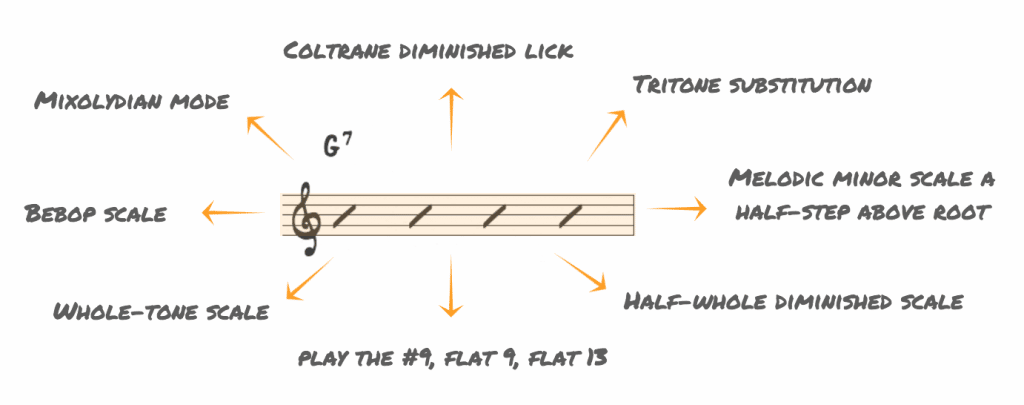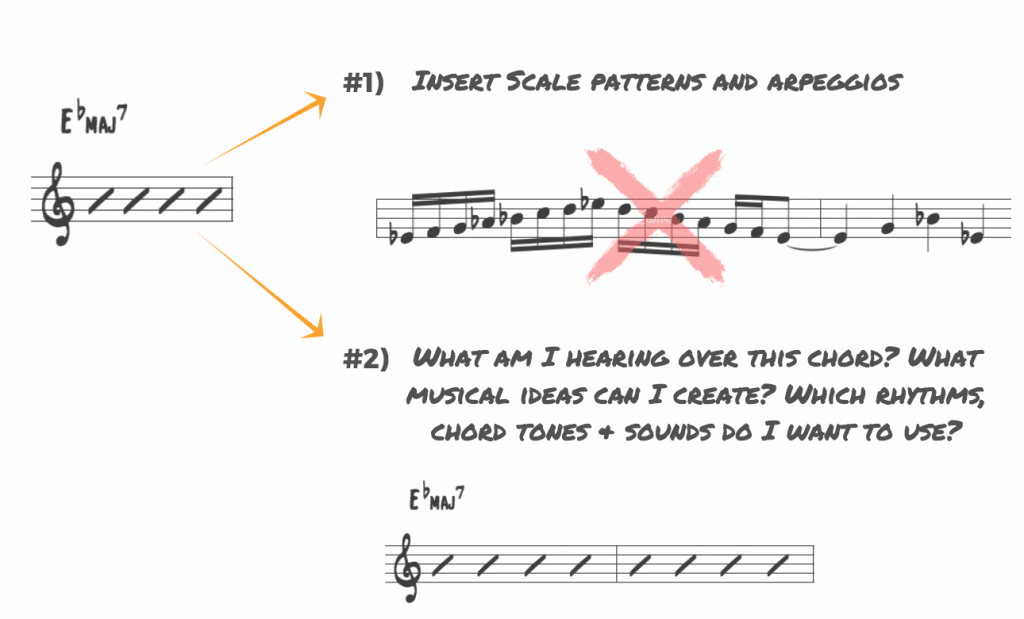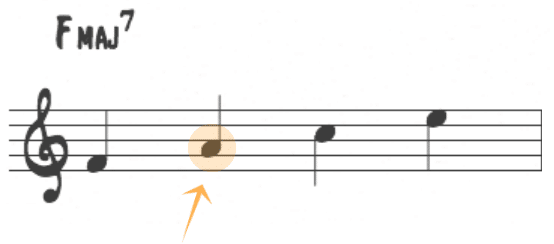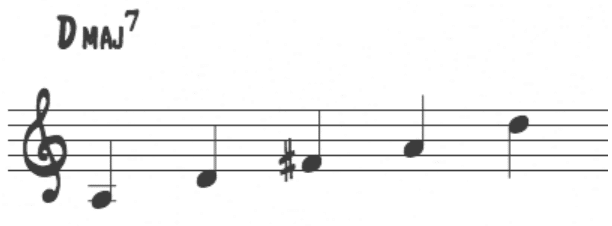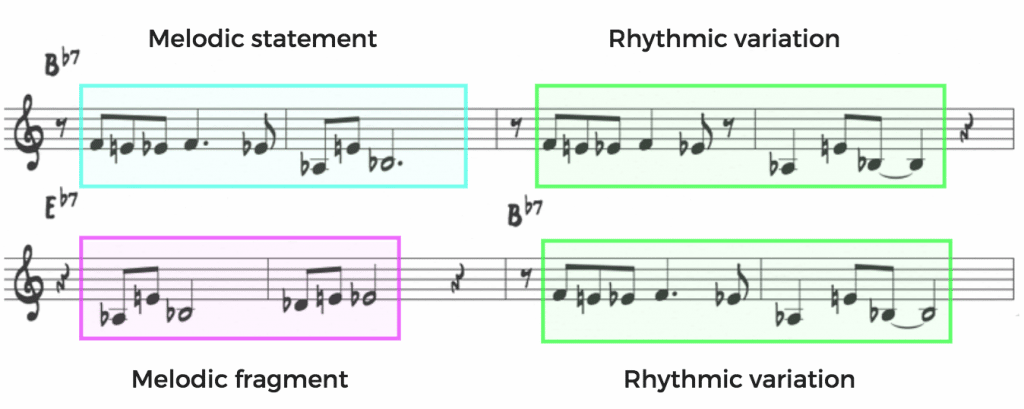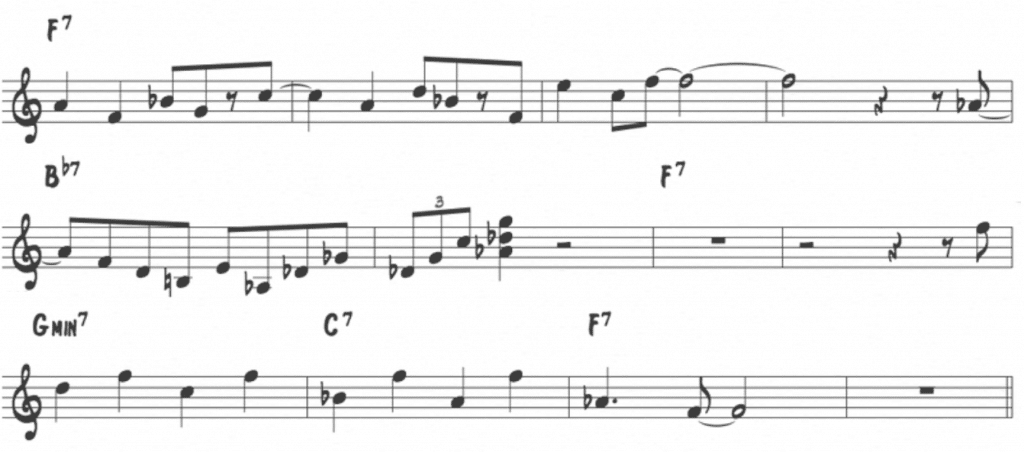Ask any musician or teacher what you should practice to develop exceptional jazz improvisation skills, and you usually hear words like “Scales” and “Modes” or “Guide-tone lines.” Sometimes even “Transcribing”…
This is all useful information. And it will help you understand the harmonic function and music theory behind all those jazz standards.
But it’s missing one essential piece to creating exceptional solos – one word that can mean the difference between years of frustrated scale practice and actually making music…
I’m talking about Melody.
You see, it doesn’t matter which instrument you play or which style of music you prefer, improvising is all about making melodic statements. Statements with notes & rhythms, with the players around you, and with the music you’re hearing in your head.
“All you can do is play melody. No matter how complicated it gets, it’s still a melody.” ~ Stan Getz
Sounds obvious, right? But it’s something that gets lost in the shuffle in the world of jazz education. The problem for many players is that they get stuck in the theory mindset of chords & scales and harmonic analysis.
…and after a few lessons, they get so overwhelmed with information that they forget about melody altogether.
To see what I mean, take a regular old dominant 7th chord. A quick look at some jazz resources will give you dozens of options that include various scales, altered notes, and substitutions:
And that’s just the stuff for V7 chords! When it comes time for you to improvise over a tune, you have to deal with Major chords, minor chords, half-diminished chords, ii-V-I progressions, and modulating keys…
Because of all the information flying at us, we end up spending a bunch of time memorizing scales and practicing exercises, yet we never get around to actually learning how to use this stuff in a musical way.
Many aspiring improvisers have memorized their scales. They can analyze a progression and pick out chord tones. They know what a ii-V-I is. But the one thing they’re missing is a basic concept for creating melodic lines.
Without melody, all of those scales, chord tones, harmonic tricks and theory terms are useless. It’s all just information until you develop a melodic approach for improvising.
That’s why today’s lesson is all about bridging the gap between the theory you know and technique you have with the music you actually want to play…
5 Simple Melodic Concepts
To develop a melodic approach to improvisation, you need to start by asking yourself this question:
“What is melody…and what makes one good or particularly effective?“
A basic definition will tell you that melody is a pleasing set of notes or a defined musical idea, but this is still a little vague. That’s why it’s best to go to the source – the music itself.
If you listen to folk melodies, great symphonic works, jazz standards, and countless show and pop tunes, you’ll find that strong melodies are built on the same recurring musical concepts.
And defining these concepts will give you some basic guide posts to help you as you start building your own melodic skills. For the majority of tunes in the jazz repertoire, you’ll find that the melodies have 5 common elements. They are:
- Relatively simple and singable musical statements
- Based on strong chord tones
- Utilize specific harmonic colors or intervallic content
- Use repetition or sequence of material
- Contain rhythmic clarity and logical phrasing
These five elements are a good starting point for studying melodic construction. Of course melody can be dissonant, rhythmically complex, or outside of the established harmony, but the first step is establishing a strong melodic foundation.
“Great melody is much simpler than most people think. With a few key devices, you can escape the complexity and confusion of music theory and start playing strong musical statements.”
There is a saying that improvising is like spontaneous composition, and this is true. Like great composers, great improvisers craft musical statements, create a mood, explore rhythmic ideas, utilize harmonic color, and build musical shapes.
And that’s what we’re going to explore today. Let’s dig into some examples of well known melodies that utilize these 5 basic melodic techniques…
I. Simple Melodic Statements
In your listening, you’ve probably noticed that master musicians can make music with only a few notes. In fact, with musical intent, sound, and rhythmic awareness even one note can be musical.
And this is one of the big differences between an amateur and a pro. Amateurs are stuck inserting scales while pros are focused on creating musical statements. Most players approach a typical chord in one of these two ways…
If you want to play more melodically in your solos you need to switch from the typical music theory, analysis mode to a mindset of creating music. You need to start making musical statements.
A composer wouldn’t sit down with a chord progression and quickly scribble out scale fragments for each chord and call it a day. And when it comes to improvising, neither should you.
To begin, let’s take a look at two melodies that use this Eb Major sound. First, take a listen to the melody of Star Eyes, played here by Chet Baker:
This simple melody is built around a major triad and the second scale degree. However, it is more than a simple scale fragment because it includes rhythmic clarity, repetition, and shape.
And unlike a scale, it’s a musical idea that you might find yourself singing …
Next, listen to the melody from Bach’s Wachet Auf, ruft uns die Stimme in the key of Eb Major:
Again we are dealing with the notes of the Eb Major scale, yet this melody is transformed into a complete musical idea.
Notice how Bach creates a logical phrase that has a beginning and end. There is melodic shape, tension notes (Ab) and resolution to chord tones.
As opposed to scales and patterns, a musical statement has intent. It’s relevant to the situation and the underlying harmony, it elicits an emotion, it has shape and direction, a beginning and an end.
II. Creating musical phrases
The next step in creating musical statements is to stop thinking in the confines of each chord, rather creating musical phrases over the bar lines.
To see what I mean, take a typical i-ii-V-i progression in E minor. The chord-scale approach to improvising puts you in the box of thinking of a different scale for each chord:
And the result from this approach is three disjointed musical ideas that are pieced together to try to create a line. Instead try to think of one simple idea that can stretch over the entire progression:
Rather than trying to hit the notes of each chord, make a melody that stretches from the beginning of the progression to the end. Here are two melodies that are a good example of this technique.
The first Manha de Carnaval performed by the great Brazilian singer Elizeth Cardoso:
Instead of a minor lick and a ii-V lick, this musical statement that reaches over the bar lines in a simple melodic way:
Keep in mind that the important part of a tune or solo isn’t the chord progression, but the melodic line. And this should be true of your solos as well.
Another melody that uses this concept is Harold Arlen’s My Shining Hour:
Again, where jazz theory might tell you that you need to play a different scale over each chord in the progression or use a guide tone line, the melody of My Shining Hour uses a 4 bar phrase:
As you practice improvising, aim to create musical statements not only over individual chords, but phrases that move between chords and over bar lines.
III. Utilize Strong Chord Tones
As we’ve shown in the above melodies, you don’t have to hit every note in a chord and you don’t have to have some crazy harmonic approach to play great melody.
You can even create melody with something as simple as chord tones.
Focusing on using the root, 3rd, 5th, and 7th of chords to create your melodic statements in a great way to simplify the process. Jerome Kern’s tune All the Things You Are is a great example of this technique in action:
The melody is based entirely on the 3rd of every chord. With this you can then focus on the shape of the line or creating a melodic sequence:
As an improviser, you should to be able to create melodic ideas with something as simple as a chord tone or triad, without relying on scales or the licks you’ve memorized.
The Major triad as melodic material
Along with singular chord tones, you can also create music with the major triad of chord:
You can create melodic shapes with this basic triad and even add a few passing tones or approach notes for emphasis.
For instance, check out how Tchaikovsky uses a D Major triad with the 4th scale degree to create thematic material in the Nutcracker, Waltz of the Flowers:
A good example of this melodic technique from the jazz repertoire is Charlie Parker’s tune Relaxin’ at Camarillo:
Again, he uses a B Major triad over a B7 chord, including the 4th to add emphasis to the 3rd:
IV. Utilize Harmonic Colors
There is an entire palette of harmonic colors that you can use in your solos, and these can be especially effective in creating melody. And you don’t need a complex line to utilize the expressive nature of these color notes.
Tones like the 9th, the Major 7th, the #11 all have a unique sound that you can incorporate into your melodic approach. Let’s look at a few well known melodies that use these tones…
A notable example if Hoagy Carmichael’s composition Stardust. Listen to Clifford Brown play the melody:
The memorable part of this melody is that it highlights the 6th of the F# Major and minor chords (D#) and the Major 7th of the F# minor chord:
Next, check out the melody to Bronislaw Kaper’s tune Invitation, played here by Joe Henderson:
Like Stardust, the thing that makes this melody unique is the color of the natural 13th (A) on a minor chord.
(The melody also include a Major 7th leap, but more on this technique below.)
Explore using different color tones to create your melodies, like the #11 over Major chords, the 11th on minor chords, or the b3 on V7 chords.
Focus on a specific melodic interval
Just as certain chord tones have a particular harmonic color, different intervals can create a melodic character for your musical phrases.
A great example of this is Kurt Weill’s My Ship, sung here by Johnny Hartman:
The expressive aspect of this melody is the ascending 5th in the first measure.
The melodic line isn’t complex or harmonically advanced, yet memorable because of the effective use of this intervalic content.
Another standard that uses intervals in a melodic way it Thelonious Monk’s tune Misterioso:
This tune is built exclusively around the intervals of a 6th.
He begins with ascending diatonic 6ths in Bb7 and switches in the next bar to diatonic 6ths in Eb7. Again, a simple melodic concept, but used in an effective way.
V. Use Melodic Sequence & Repetition
One of the most simple and natural melodic ideas is repetition – stating a musical idea and repeating it.
You’ll find this technique used in folk songs, classical music, jazz standards, and even avant garde music. And it’s a concept that you should include in your own approach to improvising melody.
Let’s take a look at a few examples from the jazz repertoire…
An obvious example of this technique is the melody to My Favorite Things. Check out John Coltrane’s famous interpretation of the melody:
This melody is built around an E minor sound, and utilizes a repeating pattern using the root and 5th of the chord:
Not only are individual notes repeated, but the first four bar phrase is repeated.
However, you don’t have to repeat the same exact material when creating melodic phrase. You can retain the shape or intervallic structure of the line as you proceed through the chord progression.
For instance, listen to the melody of the standard It Could Happen To You:
The opening two bar melodic statement is repeated in the following two measures over a different harmonic backdrop. The shape and structure of the line is retained while the harmonic material changes.
Finally, let’s look at a more complex example. Listen to John Coltrane’s tune Untitled 11383 from the newly released album Both Directions at Once:
In the melody to this blues, Coltrane states a melodic idea in the first two bars. He then alters the rhythm slightly in the next two bars and again at the end of the phrase:
This sequential technique is used in the melodies to countless standards like I Didn’t Know What Time It Was, Four, Blue Bossa, and so on…
As you work on your own solos and make a melodic statements, try to develop them through the harmony using the same techniques as the melodies above.
Applying these techniques in the practice room
The key to developing these melodic techniques in your own playing is spending focused time in the practice room on a consistent basis.
The goal is to ingrain each of these 5 techniques into your playing, so when you improvise you won’t be stuck thinking about music theory or instrumental technique.
Here are 3 tips for getting the most out of your practice time…
1) Practice making simple musical statements
The most important place to start is with the basic chords: Major, minor and V7. Isolate each chord and focus on making melodic statements. As you get started, remember to:
- Utilize chord tones or triads
- Pick an interval as the basis for your melody
- Start with rhythmic definition
- Borrow melodic ideas from the tunes you’re learning and develop them
The blues is a great place to put these skills to the test and develop your ability to create phrases. Check out how Miles Davis utilizes simple melodic statements in his solo on Blues by Five:
2) Begin your solos with a rhythmic or intervalic motif
When you practice soloing with these melodic techniques, try to get away from the typical chord/scale approach that you might be accustomed to – running scales or patterns or your go-to licks, etc.
Instead, take a moment before you play your first note and think of a single melodic idea. You might pick a rhythmic figure, a specific interval, or a harmonic color tone.
As you improvise, try to develop this original idea throughout the first few phrases of your solo. A great example of this technique is the opening to Sonny Rollins solo on St. Thomas:
3) Pair simplicity with complexity
As you become more adept at making simple musical statements, you’ll want to start adding more complexity to add interest to your phrases.
You might introduce different rhythmic ideas, larger intervals, or altered notes. Or you could pair a simple melodic statement with complex rhythms or harmonic dissonance.
Again the blues is a good place to put these techniques to the test. Check out how Chick Corea uses this idea in his tune Matrix:
In this melody, Chick pairs a simple diatonic phrase in F with a phrase that is dissonant and intervalically complex over the Bb7 chord. The result is effective for the listener and another way to approach the concept of tension and resolution.
Remember, these melodic techniques are just the beginning – the bridge from chords and scales to musical statements. From here you can explore new rhythms, complex harmonies, and the language of your musical heros.
Want to master melody??
This melodic gap in most players learning to improvise is exactly why we created the course Melodic Power.
Rather than a simple overview of melodic concepts, we dive into essential techniques for each chord you’ll encounter as a musician. And we’ve collected dozens of techniques from the solos of great players like John Coltrane, Clifford Brown, Mulgrew Miller and many more.
Inside you’ll find over 200 specific exercises to develop each melodic technique and video examples of each concept. Check out the preview here and start developing your melodic potential!

